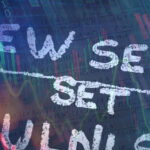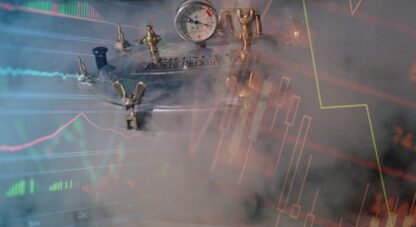The Cost of Systemic Insurance Is Rising—Guess Why
This week in financial markets may have marked the start of the next round of even higher volatility. After a big start to the week for stocks, significant selling pressure eventually entered the picture as the week progressed. A risk-off signature emerged as economically sensitive transportation stocks were crushed, along with the financial sector.
Commodities were broadly lower, with oil posting the biggest losses. WTI crude finished the week slightly under $100 per barrel for the first time since mid-March, but still closed above its 50-day moving average. More than the Biden administration’s news of a significant SPR release, the weakness in oil was likely the result of demand fears spurred both by increasing recession risks and ongoing Covid lockdowns in China. Gold was lower on the week, but mining stocks significantly outperformed, potentially hinting at coming gains in the precious metals sector. Meanwhile, the surge in yields continued this week, and the screams of incoming recession audible from the bond market escalated. Most significantly, the big dog in the curve pack—the major 2s10s yield curve spread—joined the curve inversion party with a decisive six basis point inversion to close the week.
At this point, on a macro level, we have chosen our course. While weekly prices and data releases add details to the picture, they don’t alter the fundamentally crucial variables in an equation with eventual recession on the right-hand side.
The Federal Reserve’s dual mandate is full-employment and price stability. A year ago, CPI inflation was running at 2.6%. The broad consensus narrative within markets and within the walls of Fed headquarters was that if we had a bit of inflation, it was of little consequence. It would be “transitory,” and would quickly recede once pesky reopening supply chain bottlenecks resolved themselves. The real issue, it was believed, was a weak labor market—a labor market so weak that it necessitated record levels of massive government economic policy support. Based on the diagnosis, the economic policy doctors applied the “medicine”—not by the spoonful, but by the truckload—and continued to do so for the remainder of 2021.
Much has developed over the course of the last year as it pertains to the Fed’s dual mandate. Rather than a weak labor market, we’ve got a red-hot one, and rather than 2.6% “transitory” inflation, we’ve got white-hot non-transitory 7.9%-and-rising CPI readings. What a difference a year makes.
This week we received the latest numbers applicable to both elements of the Fed’s dual mandate. First up was the Federal Reserve’s preferred inflation gauge, Core Personal Consumption Expenditures. In tune with all other inflation measures already released, February’s core PCE reading continued to broadcast warnings of excessive inflationary heat. While the Fed may have hoped for a miracle, its preferred inflation gauge offered nothing in the way of an escape from the present bind. The core PCE reading for February, which excludes food and energy prices, was 5.4% year-over-year. That marks the fastest pace of core PCE price increases since 1983, when Michael Jackson, perhaps referring to rising prices, released “Beat It.” Headline PCE, including the impact of food and energy, jumped to 6.4%. That’s the highest rate of headline PCE inflation since 1982.
As has been a consistent feature of other recently released inflation measures, the constituent components of the core and headline PCE measures continue to signal broad and intensifying price pressures throughout the economy. Of crucial importance as well, keep in mind that the report reflects the state of inflation prior to the incendiary impacts of Russia’s invasion of Ukraine. Inflation measures from this point out will begin to tell the presently untold tale of Mr. Putin’s contribution to escalating consumer-killing price increases.
On the full-employment side of the Fed’s dual mandate, the Bureau of Labor Statistics released March non-farm payrolls on Friday. Only a catastrophic, truly brutal non-farm payroll would have had even the slightest chance of derailing the policy-tightening course already all-but-set by the Fed. March payroll numbers came in at 431,000 new jobs—below the expected 490,000 and the lowest number of new monthly jobs since September. Despite the headline miss, however, any sense of weakness was offset by significant upward revisions to previous monthly numbers, and another month of strong employee earnings increases. Summing up the jobs report, Bloomberg observed, “Payrolls continue to advance, the jobless rate is nearing a decades-low level, and [employee wage] earnings are exploding.”
The most important story within the report, however, was those wages. March average hourly employee earnings posted a 0.4% increase on the month—a notable rise from 0.1% in February. There are millions more open jobs that need filling than unemployed workers to fill them. As a result, businesses are necessarily raising wages to compete for needed workers. To compensate for the increased labor costs, however, these businesses must turn around and increase the prices for their goods and services. So spins the wage-price spiral. The crucial implication from this jobs report is that the wage-price spiral appears, at this point, firmly entrenched. These dynamics now constitute a powerful inflation engine running hot at the heart of the economy.
We already have too much money chasing too few goods. We also have a war and related sanctions that are greatly exacerbating already problematic inflationary shortages and supply chain issues. Along with the full-blown wage-price spiral, these inflation factors are in a coordinated boom, and the resulting consumer price inflation cocktail is potent. In addition, the critical dynamics in play strongly suggest that still higher inflation is imminent.
The enormous wrench in the works here is that wages are not keeping up with the rise in consumer prices. These “exploding” wages are actually shrinking on a “real” inflation adjusted basis as they trail the moonshot in consumer prices. With the way this die is loaded, the consumer loses big. At the same time, reflecting the impact of these negative real wages, the consumer savings rate has plummeted back below pre-Covid trend levels. Under present conditions, the consumer is living on borrowed time.
The narrative playing out here is a grim one, and critical factors are rapidly coming to a head. For many months, the University of Michigan Surveys of Consumers have increasingly confirmed that the inflation problem is not just an inconvenient statistical calculation on a government report, but a real-life problem that has penetrated the home of the American consumer. With the endless array of high-decibel economic noise, sometimes it is hard to hear the simple economic truth. At the end of the day, it is the experience of real people that defines the health of an economy.
Right now, that consumer experience is one of expectations for worsening personal finances at the largest proportion since UMich records were first kept in the mid-1940s. That same consumer voice speaks of the experience of “reduced living standards” at the highest frequency outside of the two biggest recessions of the last 50 years. These findings are alarming. They are downright terrifying when considering that stocks are still within spitting distance of all-time highs, and the labor market is still expanding.
The Conference Board also conducts a monthly Consumer Confidence survey. One of their measures aims to get a handle on the rate at which present consumer conditions are deteriorating. To do this, the Conference Board gauges the spread differential between the consumers’ present situation vs. their confidence about future conditions. A trending deterioration in consumer health is reflected when future expectations score even more negatively than present conditions. This is the case at present. We have a trending deterioration in consumer health. In fact, this spread measure has never been as negative as it is now without a recession following in short order—or without one already ongoing. In this context, the recession signals emanating from the slew of recent bond market yield curve inversions should be taken extremely seriously.
Unless economic conditions miraculously change immediately and dramatically for the better, consumer spending behavior, which constitutes 70% of GDP, will turn ever more cautious and conservative. As the consumer pulls back, economic demand destruction will result. To assume under these conditions that the gears of the economy will not slow dramatically and recess is to assume far too much.
The recessionary writing is on the wall. At this point, it is the persistence of negative real wages, the deepening of the below-trend savings rate, and signs of demand destruction that need to be carefully watched. Once demand destruction begins in earnest, the party will be over and the economic down cycle will gain momentum. Once the consumer stops paying for the higher prices of corporate goods and services, prices will have to fall. If prices fall, wages will stop “exploding” higher, and the wage-price inflation spiral will become the price-wage deflation spiral as the process reverses. This carries immediate self-reinforcing consequences for both consumers and the corporate sector.
Signs that we may be approaching this turning point are just starting to appear. A note this week from Morgan Stanley observed that their analysis of corporate earnings reports and small business surveys indicates that labor costs are now a great concern. According to the bank, “Price increases to offset higher wages may soon lose steam as demand destruction is emerging in consumer end markets.” The bank goes on to state that, “Corporate concern about wages has reached new highs.”
With the consumer on life support, signs of demand destruction beginning to emerge, and businesses expressing great concern over high labor costs, corporate earnings and margins face great risk in 2022. Morgan Stanley now expects pretax corporate profit margins to fall from 17.8% to 10.7% this year—a far more ruinous deterioration than average Bloomberg analyst expectations for margins of 16.5% in 2022. As such, despite the recent historic bear market rally, stock indexes are at tremendous risk. This week, Bank of America described the stock rally as “Not explained by fundamentals” and taking place despite clearly deteriorating macro fundamentals.
Those clearly deteriorating macro fundamental drivers will also be acerbated by the Federal Reserve’s newfound determination to fight last year’s inflation battle well after it’s already been lost. It seems far too late at this point for the Fed to unwind the mess wrought by inflation and deliver a featherbed landing that curbs inflation while maintaining economic growth. In fact, Fed policy tightening will almost certainly accelerate and accentuate the down cycle. At this point the Fed may well understand that a recession is now needed to subdue inflation.
The new and crucial battle for the Fed may be to fight for credibility. As Mohammad El-Erian said in a Bloomberg interview, referring to the Fed, “They have lost credibility when it comes to inflation fighting. They have lost credibility in terms of their ability to forecast inflation. And they have lost control of their policy narrative.” With their credibility on the line, and the battle to stave off recession likely already lost, this Fed may knowingly and willingly tighten policy and financial conditions right into the teeth of an incoming recession.
The question then becomes, what happens next? While the Fed may choose to continue a tactical tightening in the near term, there is absolutely no indication that policymakers are ready to permanently retire the problematic Keynesian policy framework that continues to inch us down the plank toward a final economic reckoning. We can see that clearly in the bond market futures curves. Though they price in multiple rate cuts in line with the current hiking cycle, they also indicate expectations that, after a hard landing, the Fed will revert to inflationary policies in very short order.
Over recent weeks, HAI has attempted to highlight and identify fundamentally untenable political and economic policies as the root cause of the problems we face. America’s favored economic framework, in place for decades, is built on illogical and unsustainable foundations. Policymakers habitually apply shortsighted, inherently unsustainable policies with devastating long-term cumulative accruing consequences. Every time the next manifestation of acute crisis flares and the bill comes due, we act with little more than a repeated commitment to double down on the wrong policy path for the sake of short-term expedience. Every time we do this, we perpetuate the doom-loop, enlarge the size and scope of our ultimate problems, and shrink policymaking optionality towards lose-lose. All the while, we cynically sacrifice the long-term promise of a better tomorrow. This approach will never solve our problems. Instead, our policies have created an ever-growing time bomb. Our approach is not sustainable.
Philosopher Alexander Skutch made the powerful observation that “The common feature which unites the activities most consistently forbidden by the moral codes of civilized people is that by their very nature [the forbidden activities] cannot be both habitual and enduring, because they tend to destroy the conditions which make them possible.” In other words, the common denominator is unsustainability.
As economist and former Weekly Commentary guest Hunter Lewis clarifies, “Economics in the final analysis is grounded in logic. Good economics is always logical, which means…above all sustainable.” The theories underpinning our economic policies since abandoning the gold standard are Keynesian/MMT in nature, and inherently unsustainable. The long-term fundamentally unsustainable nature of the Keynesian economic framework are so readily apparent, Lord Keynes himself could only dismiss criticisms with the cynical quip, “in the long run, we’re all dead.”
These economic policies recklessly debase the currency with unapologetic monetary inflation. They cause debilitating bouts of consumer price inflation and unleash destabilizing and economically damaging boom-bust cycles. The policies also add unimaginable amounts of debt to the system that, as accumulated, inversely impact economic growth potential. Over time, the whole untenable scheme creates the conditions for its own destruction—the very definition of unsustainable.
Inflation as policy was always understood to be a nearly irresistible temptation for politicians and policymakers to use and abuse. So much so that a gold standard was universally adopted as wisdom born out of humility. It was the responsible economics version of the cornerstone innovation of American constitutional checks and balances. However, so powerful is the allure of short-term political advantage that can initially be had from inflationary policies that entire schools of crank economics were created and marketed to justify the use of such policies and the retirement of the gold standard.
As former Treasury Secretary William Simon rightly observed, people “hate inflation but love everything that causes it.” As such, the real trick for policymakers seeking advantage has therefore been to lavish voters with the beloved policies that cause inflation while simultaneously controlling and directing the inflationary flows into initially less-problematic areas than consumer prices. Inflating stock prices, financial asset bubbles, and the resulting wealth effect are celebrated as long as consumer prices remain low. The game is up, however, and the popular hatred of inflation returns in earnest as soon as inflation inevitably leaks into the real economy and consumer prices. This is where we stand at present. Consumer price inflation is the Achilles’s heel of modern central banking, and we have a severe case of it now.
Once off the gold standard, the world entered a bold new era. A system once firmly tethered to the checks and balances of the gold standard passed into the hands of a central authority of politicians and central bankers. In this bold new era, policymakers became the new default keepers of monetary order. In the wake of the gold standard, central bank credibility became a market factor of paramount importance. Gold became insurance against the policymakers’ errors and the resulting threats to the system. As a result, gold prices have become inversely correlated with central bank credibility.
When credibility is high because policymakers act responsibly and apply strict discipline to the monetary order, as Former Fed Chairman Paul Volker did in the early 1980s, the price of insurance falls. Since that time, however, policy discipline has increasingly vanished, and we have pushed Keynesian-based policies to the point of introducing very real existential threats to the economy and the currency. Policy optionality has now shrunk to where we are beyond the Volker option. Under the current policy regime, the risk of recession and the next round of inflationary policy responses already loom. Central bank credibility is deservedly low. At present, it is also at great risk of plummeting much further into a crisis of confidence. With the next storm already clearly visible on the horizon, expect the price of insurance to rise accordingly.
Weekly performance: The S&P 500 was nearly flat, up 0.06%. Gold was off by 1.56%, silver was down 3.75%, platinum lost 1.97%, and palladium dropped 5.30%. The HUI gold miners index significantly outperformed the physical precious metals this week, gaining 2.09%. The IFRA iShares US Infrastructure ETF gained 0.59% on the week. Energy commodities were volatile and mixed. WTI crude oil was down 12.84%, while natural gas was up 1.96%. The CRB Commodity Index was lower by 3.83%, while copper shed 0.26%. The Dow Jones US Specialty Real Estate Investment Trust Index was up 4.88% on the week, while the Vanguard Utilities ETF (VPU) was up 3.69%. The dollar was lower by 0.49% to close the week at 98.36. The yield on the 10-year Treasury dropped by 10 bps to end the week at 2.38%.
Have a wonderful weekend!
Best Regards,
Morgan Lewis
Equity Analyst and Investment Strategist
MWM LLC
















